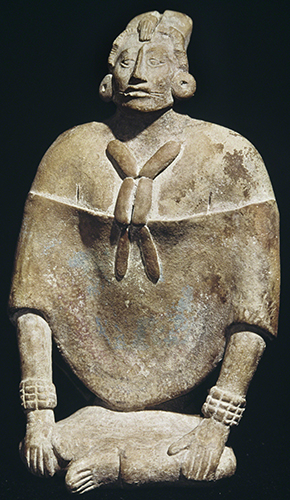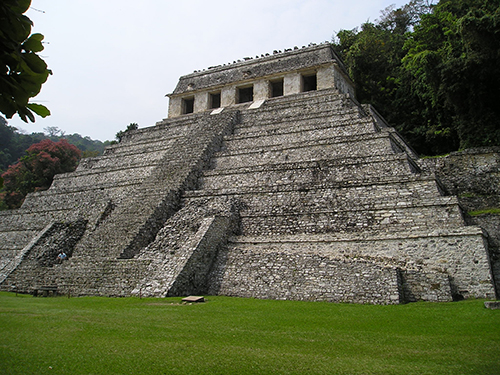Hispanic Heritage Month: Maya Culture
For today’s Hispanic Heritage Month post, let’s look at the Maya culture. The early Pre-Classic Mayans occupied Chiapas in Mexico, Honduras, and Guatemala until between 400 and 50 BCE, when they began to spread to the Yucatan Peninsula. After centuries of egalitarian village living, they adapted a hierarchic, autocratic city-state way of life. Although the reasons for the change are unknown, the platform pyramids, organization of cities, and the rule of warrior-priests represent the influence of Olmec culture and that of another early city-state culture in Teotihuacán (see Wednesday’s post). By the 200s CE, the Mayan lands included El Salvador, Honduras, Guatemala, Belize, and Mexico. The Mayans were truly one of the greatest civilizations of antiquity.
 |
| Maya Culture, Seated Female Dignitary, 500–800 CE. Ceramic, height: 6 11/16" (17 cm). Private Collection. Image © 2019 Davis Art Images. (8S-11254) |
Jaina Island is a small limestone island off the Yucatán Peninsula about 50 miles north of the city of Campeche. The island was first settled about 300 CE and was abandoned about 1200. Jaina was once an elite Maya burial site with an estimated 20,000 graves, of which about 1,000 have been excavated. It is famous for the ceramic figurines that are found in the graves. The graves contain the human remains with one or more ceramic figurines on their chest or held in their hands, as well as glassware, slate ware, pottery, hand woven cotton mats, or other ceremonial objects.
Some of these figures were either whistle or rattle objects as well, placed in the hands of the deceased. Although their function in the tomb is not certain, it is probable that they served the same function as the human ceramic figures in ancient Chinese burials—to serve the needs of the deceased in the afterlife. They may have also served to represent the status of the deceased.
This figure is known as a dignitary because of her jewelry, although he poncho-like outfit is depicted on ceramic figures of more humble stations in life such as weavers at a loom. Figures in this pose were often the product of molds. Hand-sculpted figures such as this, with numerous fussy details of costume—including the clay poncho overlaid on a completely sculpted body—are typical of earlier periods, before Jaina Island became a fashionable burial location for the Mayan elite.
 |
| Maya Culture, Temple of Inscriptions, Palenque, Mexico, ca. 683–692 CE. Photograph by Strobilomyces. CC BY-SA 3.0. (8S-11353) |
No, the ancient Egyptians did not sail across the Atlantic to teach the Mayans pyramid building, check the dates of Egyptian pyramid building…Old Kingdom, 2650–2152 BCE! Cultures across the planet have constructed temples to their gods that resemble holy mountains, and the Mayans were no exception.
Like most Mayan temples, the Temple of Inscriptions sits atop a stepped pyramid. The temple is named for the one of the longest known excavated hieroglyphic inscriptions (617 glyphs). The pyramid was built as a mortuary shrine to Palenque's most illustrious ruler, Lord Pacal (died 683 CE). The Temple of Inscriptions is the tallest structure in Palenque, taller even than the palace tower. The burial crypt of Pacal, same as in Egyptian pyramid tombs, is located down an air shaft from the rear room of the temple.
Palenque is one of the most beautifully laid out Mayan cities. The architecture is inventive and elaborately decorated with relief sculpture. It is well adapted to the humid climate with vaulted chambers containing cross ventilation, and orientation away from the sun at its height during the day. The elevated site commands a view of the great plains stretching to the distant horizon, alerting the rulers of Palenque to approaching threats or important visitors.
Because the Mayans had no draft animals or wheels, they used the many rivers as their main transportation arteries from city to city. Not far from Palenque is the Umusacinto River, which was the city’s main trade route. This was an important artery because it allowed communication between cities along the Bay of Campeche and inland to the Petén. Maya rulers could participate in neighboring ceremonies and festivals, and architects could exchange views on techniques and current styles in each the various city centers.
Check back Monday for the final post in my Hispanic Heritage Month series about the Mixtec culture.


Comments